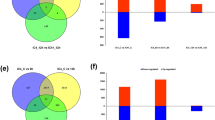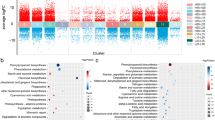Abstract
Epicuticular wax serves as an interface with the environment and thus plays an important role in the resistance to various biotic and abiotic stresses. Previously, we identified the wax-deficient mutant w5, and GC–MS profiling showed that β-diketone biosynthesis was completely blocked and the content of some other components also decreased significantly in the w5 mutant. In the present study, comparative transcriptome profile of the flag-leaf sheath between the w5 mutant and its wild type was performed, and the expression patterns of differentially expressed genes in wax metabolism pathway were analyzed. The results showed that a total of 767 differentially expressed genes were identified and they were mainly enriched in wax biosynthesis and transportation pathways by Gene Ontology (GO) analyses. Further analysis showed that the expressions of epicuticular wax metabolism-related genes were almost significantly downregulated, which might contribute to the dramatic decrease of the epicuticular wax content in the w5 mutant. Here, our study delineated a transcriptional landscape of the wax metabolism regulatory genes in the w5 mutant and paved a way for further exploring the molecular mechanisms of epicuticular wax metabolism in wheat.




Similar content being viewed by others
Data Availability
Raw data of this study have been deposited in the GenBank databases under accession number PRJNA685921.
References
Bernard A, Joubès J (2013) Arabidopsis cuticular waxes: advances in synthesis, export and regulation. Prog Lipid Res 52:110–129
Bernard A, Domergue F, Pascal S, Jetter R, Renne C, Faure JD, Haslam RP, Napier JA, Lessire R, Joubès J (2012) Reconstitution of plant alkane biosynthesis in yeast demonstrates that Arabidopsis ECERIFERUM1 and ECERIFERUM3 are core components of a very-long-chain alkane synthesis complex. Plant Cell 24:3106–3118
Bird D, Beisson F, Brigham A, Shin J, Greer S, Jetter R, Kunst L, Wu X, Yephremov A, Samuels L (2007) Characterization of Arabidopsis ABCG11/WBC11, an ATP binding cassette (ABC) transporter that is required for cuticular lipid secretion. Plant J 52:485–498
Chen Y, Song W, Xie X, Wang Z, Guan P, Peng H, Jiao Y, Ni Z, Sun Q, Guo W (2020) A collinearity-incorporating homology inference strategy for connecting emerging assemblies in triticeae tribe as a pilot practice in the plant pangenomic era. Mol Plant 13:1694–1708
Dehesh K, Tai H, Edwards P, Byrne J, Jaworski JG (2001) Overexpression of 3-ketoacyl-acyl-carrier protein synthase IIIs in plants reduces the rate of lipid synthesis. Plant Physiol 125:1103–1114
Hen-Avivi S, Savin O, Racovita RC, Lee WS, Adamski NM, Malitsky S, Almekias-Siegl E, Levy M, Vautrin S, Berges H, Friedlander G, Kartvelishvily E, Ben-Zvi G, Alkan N, Uauy C, Kanyuka K, Jetter R, Distelfeld A, Aharoni A (2016) A metabolic gene cluster in the wheat W1 and the barley Cer-cqu loci determines beta-diketone biosynthesis and glaucousness. Plant Cell 28:1440–1460
Jetter R, Kunst L (2008) Plant surface lipid biosynthetic pathways and their utility for metabolic engineering of waxes and hydrocarbon biofuels. Plant J 54:670–683
Kim H, Lee SB, Kim HJ, Min MK, Hwang I, Suh MC (2012) Characterization of glycosylphosphatidylinositol-anchored lipid transfer protein 2 (LTPG2) and overlapping function between LTPG/LTPG1 and LTPG2 in cuticular wax export or accumulation in Arabidopsis thaliana. Plant Cell Physiol 53:1391–1403
Kim J, Jung JH, Lee SB, Go YS, Kim HJ, Cahoon R, Markham JE, Cahoon EB, Suh MC (2013) Arabidopsis 3-ketoacyl-coenzyme a synthase9 is involved in the synthesis of tetracosanoic acids as precursors of cuticular waxes, suberins, sphingolipids, and phospholipids. Plant Physiol 162:567–580
Lee SB, Suh MC (2015) Advances in the understanding of cuticular waxes in Arabidopsis thaliana and crop species. Plant Cell Rep 34:557–572
Lee SB, Go YS, Bae H-J, Park JH, Cho SH, Cho HJ, Lee DS, Park OK, Hwang I, Suh MC (2009) Disruption of glycosylphosphatidylinositol-anchored lipid transfer protein gene altered cuticular lipid composition, increased plastoglobules, and enhanced susceptibility to infection by the fungal pathogen Alternaria brassicicola. Plant Physiol 150:42–54
Leibundgut M, Jenni S, Frick C, Ban N (2007) Structural basis for substrate delivery by acyl carrier protein in the yeast fatty acid synthase. Science 316:288
Li L, Qi Z, Chai L, Chen Z, Wang T, Zhang M, You M, Peng H, Yao Y, Hu Z, Xin M, Guo W, Sun Q, Ni Z (2020) The semidominant mutation w5 impairs epicuticular wax deposition in common wheat (Triticum aestivum L.). Theor Appl Genet 133:1213–1225
Livak KJ, Schmittgen TD (2001) Analysis of relative gene expression data using real-time quantitative PCR and the 2−ΔΔCT method. Methods 25:402–408
Luan H, Shen H, Zhang Y, Zang H, Qiao H, Tao H, Chen J, Chen H (2017) Comparative transcriptome analysis of barley (Hordeum vulgare L.) glossy mutant using RNA-Seq. Braz J Bot 40:247–256
Mcfarlane HE, Shin JJH, Bird DA, Lacey A, S, (2010) Arabidopsis ABCG transporters, which are required for export of diverse cuticular lipids, dimerize in different combinations. Plant Cell 22:3066–3075
Owen R, Huanquan Z, Hepworth SR, Patricia L, Reinhard J, Ljerka K (2006) CER4 encodes an alcohol-forming fatty acyl-coenzyme A reductase involved in cuticular wax production in Arabidopsis. Plant Physiol 142:866–877
Reina-Pinto JJ, Yephremov A (2009) Surface lipids and plant defenses. Plant Physiol Biochem 47:540–549
Rowland O, Lee R, Franke R, Schreiber L, Kunst L (2007) The CER3 wax biosynthetic gene from Arabidopsis thaliana is allelic to WAX2/YRE/FLP1. FEBS Lett 581:3538–3544
Schneider LM, Adamski NM, Christensen CE, Stuart DB, Vautrin S, Hansson M, Uauy C, von Wettstein-Knowles P (2016) The Cer-cqu gene cluster determines three key players in a beta-diketone synthase polyketide pathway synthesizing aliphatics in epicuticular waxes. J Exp Bot 67:2715–2730
Wang T, Xing J, Liu X, Yao Y, Hu Z, Peng H, Xin M, Zhou DX, Zhang Y, Ni Z (2018) GCN5 contributes to stem cuticular wax biosynthesis by histone acetylation of CER3 in Arabidopsis. J Exp Bot 69:2911–2922
Zhang Z, Wang W, Li W (2013) Genetic interactions underlying the biosynthesis and inhibition of β-diketones in wheat and their impact on glaucousness and cuticle permeability. PLoS ONE 8:e54129
Acknowledgements
This work was financially supported by the National Natural Science Foundation of China (31991214) and the National Key Research and Development Program of China (Grant no. 2017YFD0101004).
Author information
Authors and Affiliations
Contributions
JX and ZN conceived the project; LL carried out experiments; ZZ, YZ, ZS and MY participated in field trials; WS analyzed experimental results; LL, ZN and JX wrote the manuscript.
Corresponding author
Ethics declarations
Conflict of interest
All the authors declare no conflict of interests.
Supplementary Information
Below is the link to the electronic supplementary material.
Rights and permissions
About this article
Cite this article
Li, L., Zhang, Z., Song, W. et al. The Essential Role of W5 in Wax Metabolism in Wheat (Triticum aestivum L.). J. Plant Biol. 65, 311–317 (2022). https://doi.org/10.1007/s12374-021-09325-2
Received:
Revised:
Accepted:
Published:
Issue Date:
DOI: https://doi.org/10.1007/s12374-021-09325-2




